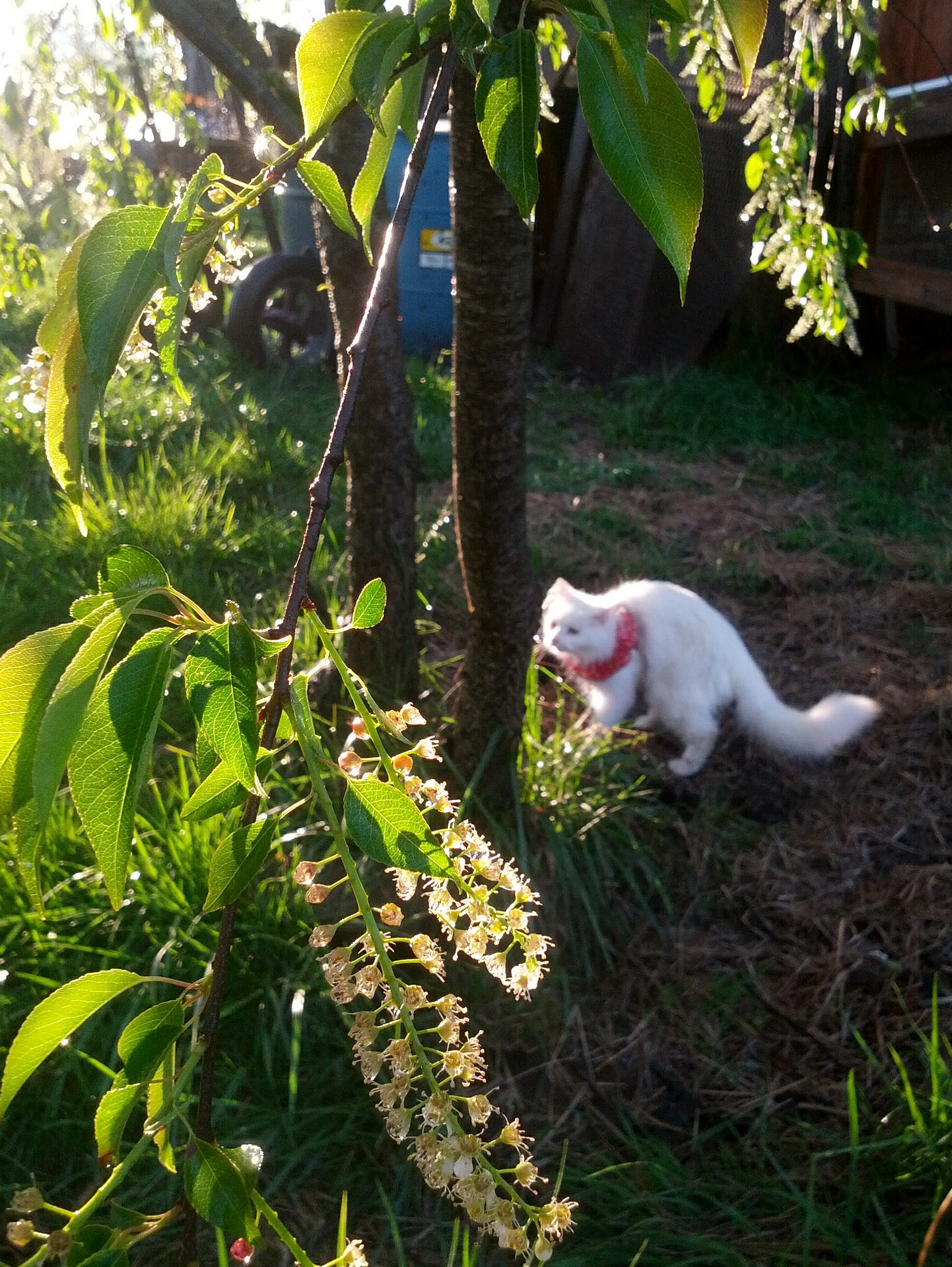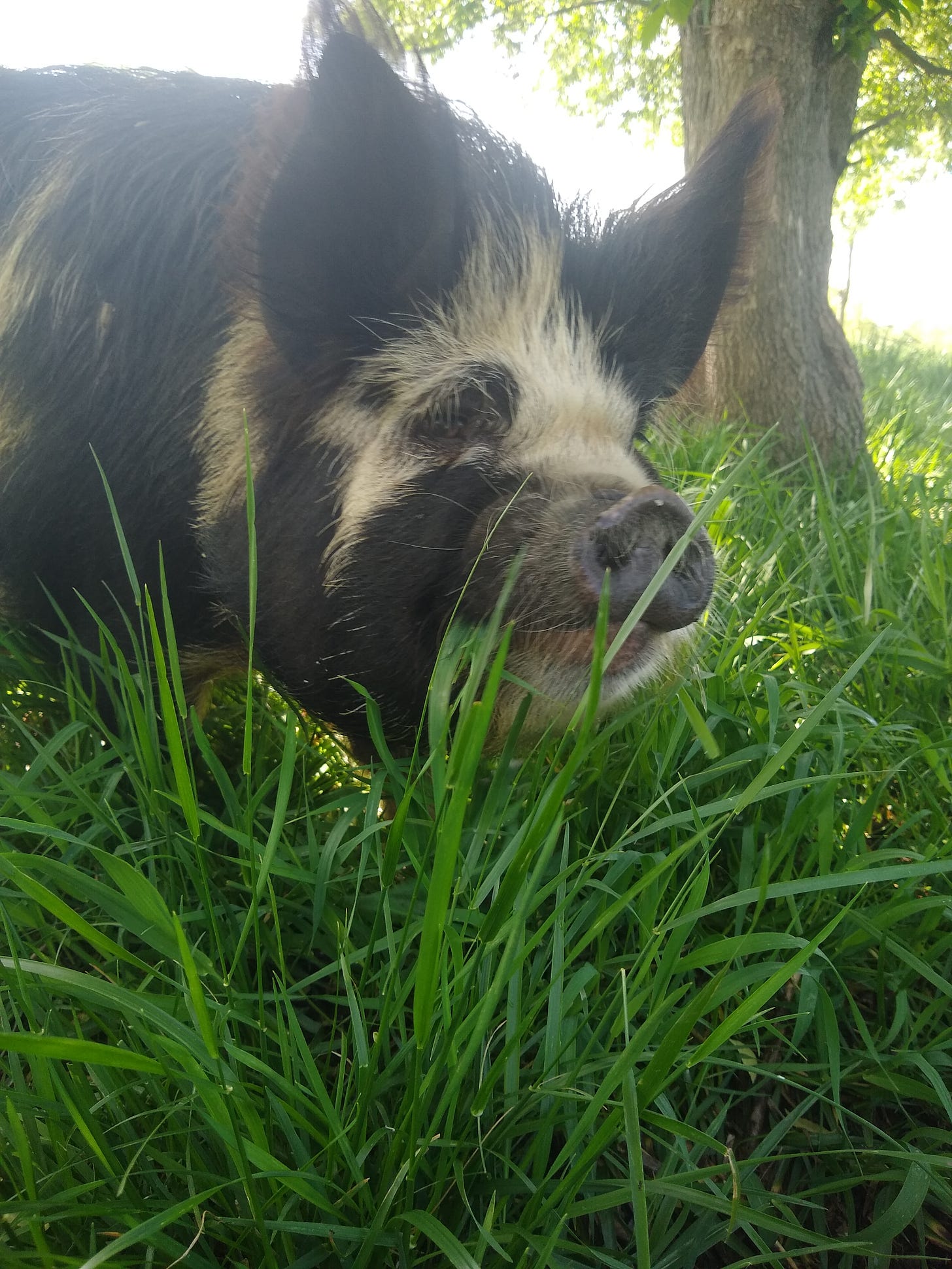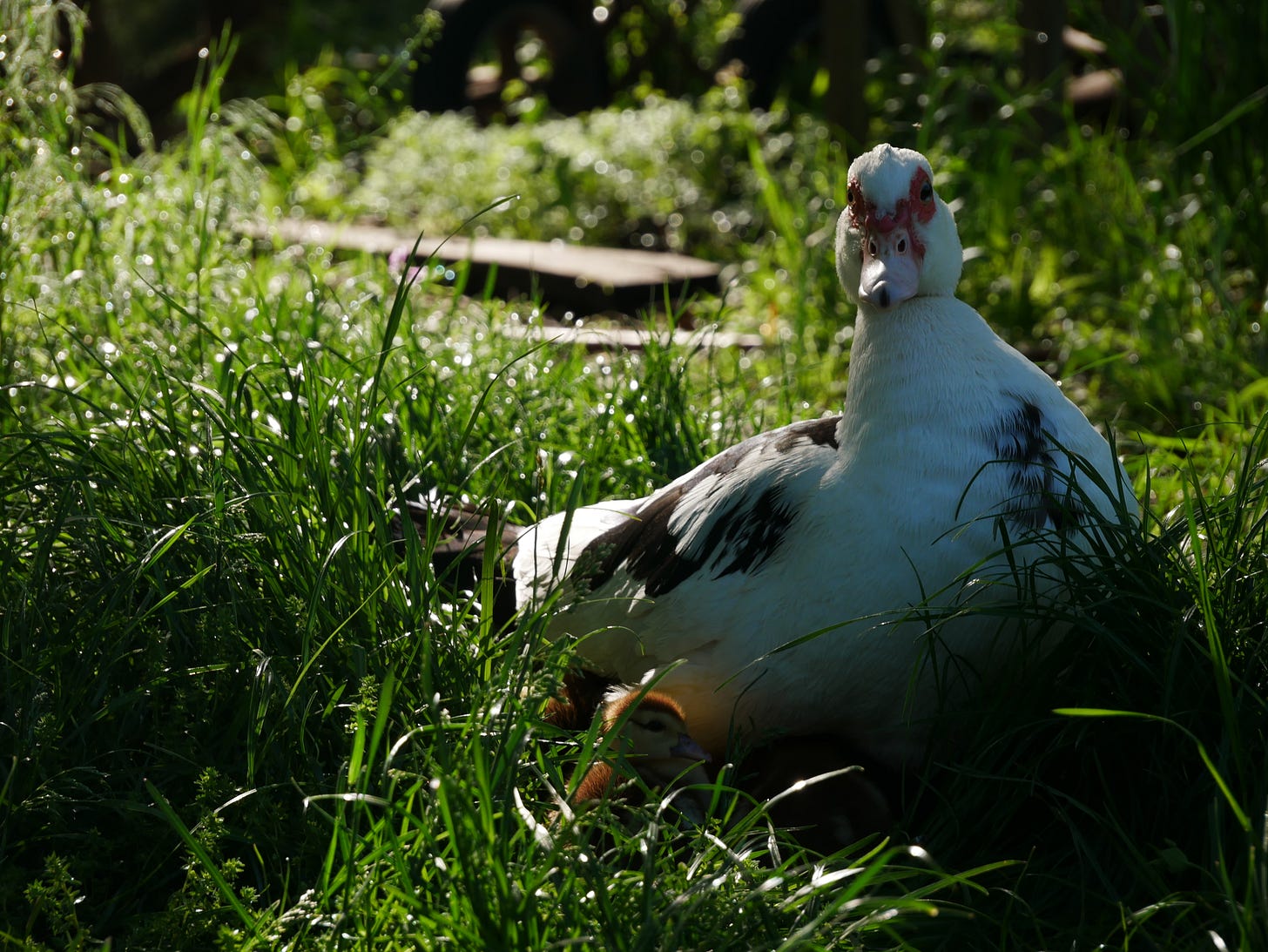Death, Manure, and the Outward Spiral of Photosynthetic Momentum
Our status quo global food system begs many questions... are we getting honest answers?
As creamy white racemes of wild black cherry fade, and their blooms flutter earthward in the intermittent winds, they tend to rain upon the small herd of swine laid out in repose beneath the rejuvenated spring canopy, not yet battered by fierce weather or dulled with summer dust. The heaving bristles of hogs’ backs and sides catch the precipitating petals and hold them like freckled snow, or perhaps the slumber-time rhinestone bedazzling of the prairie savanna equivalent of a wood nymph.
The hogs, grass stains upon their maws and flecked with flower petals, are finally out of their sufficient, but largely barren and muddy sty, and onto fresh, cool-season grass and forage beneath brittle arches of box-elder maple and the aforementioned wild cherry. Ample rain and uninterrupted warmth are now allowing for continual growth of grass, and a gradual, yet sudden splash of germination– horseweed, wild grape seed, and feral sunflower– stirs in the bare garden beds and soft blank spaces between waking clumps of prairie sod.
Consistent with the ever-greening and growing space between branches and across fields and hedgerows, a sky once largely quiet, only punctuated with the whistling of meadowlarks and scolding of jays is suddenly nearly symphonic with the chatter of house wrens, undulating whistles of yellowthroats, and melodic intervals of warbling vireos. Orioles serenade each other from the bending tips of oak and elm, and hidden in a tangle of leaf and limb, the brown thrashers erupt in an avant garde medley of twinned-up tunes. They say that in spring, a young man’s fancy turns to thoughts of love– but as a person of middle age (and I suspect I may be past the actual middle of my age when accounting for stress and other factors), my thoughts have primarily turned to bird migration season. A flash of yellow in the boughs of oak pulls my attention from the task at hand, as does the quick glimpse of some unknown flycatcher or the vague silhouette of some unrecognized swallow. I strain my ears in the woodlands for faint warbles and unfamiliar song– even in these activities which purport to bring myself into closer accord with the ever-shifting natural world, I find myself employing the cold analysis of Western, colonial scientific categorization and “understanding”— binoculars, field guides, and smartphone apps. Hopefully, I am only employing these toward harmless ends and greater understanding. Still, communing with nature, for me, often encompasses a great deal of classification, contemplation, and light research. I do not just vibe these days, nor have I for a long time.
Vibe or no vibe, there is plenty of work to do in this time of explosive vegetative growth– I call it the outward spiral of photosynthetic momentum, when the sudden resplendence of green grass requires that our agricultural activities– particularly those pastoral in nature– rapidly move and spread outward toward the furthest edges of the landscape, in pursuit of solar-energy made flesh in the form of leaf sugars. The warm-season grasses we rely on through summer are still vulnerable to being overgrazed, their rooted, perennial reserves of nutrition still largely bearing the metabolic burden of the organism until their sluggish leaves grow thick in the coming heat. For now, we must largely stick to cool-season grasses, which in our experience, all seem to want to rush to flowering early. When grasses flower, the ratio of nutritious protein to largely indigestible lignin shifts towards unpalatability, and ruminant livestock begin to find them unappealing, while we find the results to be largely inefficient, production-wise.
The best way we can manage to keep grazing cool-season grasses until the warm-season grasses are ready to hit is by not allowing them to flower. When grass is grazed or mowed, the flowering clock is slightly reset– reproductive growth reverts to vegetative growth. Each time we hit the reset on our grass, the time until it finally flowers is, however, shortened. With well-timed and organized management, we ought to be able to reset each cool-season paddock at least once, and hopefully twice. Of course, there is always a risk in overgrazing this way. Each time a grass plant is trimmed or grazed, an amount of the root mass dies off, approximate to what has been nibbled– as above, so below. This root mass, the captured energy of the sun made into sugar, becomes soil-carbon and resultantly, the organic matter of our pastures increases– maybe. But if too much is taken too frequently, the grass dies back more heavily, and the soil is therefore more vulnerable. By using slower-grazing pasture pigs as a placeholder in some of our cool season paddocks, the grass can be “put on hold” until cattle can come along and utilize it. It’s all rather complicated on a map, and in practice.
There are many other factors which can further impact whether or not this increase in organic matter, and hence, sequestered carbon, actually occurs meaningfully, such as erosion, over/under grazing, the presence or absence of certain microbiota, or the farmer’s self-confidence and willingness to tell lies for a higher rung of the market share. Some folks would call it regenerative grazing, but it’s mostly just common sense, and like all the warblers and vireos and flycatchers, managing grazing livestock in a way that maintains soil and ecosystem health alongside that of the herd and human community has existed for a long time before white folks decided to give it an official name.
Much like what I like to call “hashtag permaculture”, “hashtag regenerative grazing” is something I would define as being the cynical exploitation of a potentially viable alternative to destructive, conventional agricultural practices. Both are riddled with assumptions and untested hypotheses, but marketed as clear and obvious solutions. Both are rooted in relatively young fields of study, which are in turn rooted in (or taken from, with or without permission) relatively ancient modes of practice, and both apply generalized solutions to localized problems. Can swales and hugelkultur be used effectively to modify the flow of water across the landscape? I don’t know… depends on the landscape. Can management intensive mob grazing be effectively leveraged for soil health and carbon sequestration? Well, it all depends on innumerable variables. We can employ observation, or each and every regenerative-claiming operation can publish peer reviewed data on their organic matter and soil carbon levels over a period of decades, and either way, we’ll have much more work on our plates as a civilization to make what we learn applicable, replicable, and reasonable to perform, perhaps after it’s much too late to undo the damage of a couple centuries of deeply extractive agriculture.
I see the rush to market solutions that aren’t fully researched or understood as greatly detrimental to the legitimacy of the proposed alternatives, if not potentially damaging to an already threadbare and brittle soil-carbon-ecosystem web when they are carried out without a deeper level of research and understanding. It doesn’t mean we oughtn’t try, or that regular growers like myself should not feel empowered to work with alternatives. It just means that there is inherent danger in offering and marketing panaceas, when the margin of error on an ever extracted and degenerated planet is too thin to play games with.
Another problem I see with the popularization and marketing of so-called regenerative agriculture is contextual. Specifically, the context of capitalism. I think most of my readers likely have some suspicions regarding the efficacy of a system that claims to regenerate so much, but only feeds a select segment of the population, and requires untold inputs of energy and resources to remain economically viable by putting packaged foods in the hands of folks who can afford them– namely those well outside the ecological community of their production. To be clear, the ability of modern commercial infrastructure to put significant quantities of stable foodstuffs like beans and grains into the mouths of folks who need nutrition is probably sensible. 12 ounce portions of plastic packed regenerative beef shipped out to mainstream chain grocers probably isn’t. Non-perishable staples are a necessity for many folks, and a perfectly common-sense way to eat. Chilean grapes in winter are not, at least in my hemisphere. One can sit in a boxcar or shipping container for months, with no loss in quality, whereas the other has a higher embodied energy cost in expedited transportation and climate control.
The context of capitalism also wreaks havoc on hypothesized benefits of regenerative agriculture in another vital way: resource and fertility cycling. A regenerative beef ranch exports meat, bone, and hide. If they are purely grass-fed, and winter hay is baled on site, the only imports at most may be the purchased cattle themselves, which grow and take away more than the leave. If feed or fertility is imported, the question becomes at what cost to other land was it made available? In a world which, through economic function, seems to necessitate an increasingly urbanized population, we no longer shit where we eat, so to speak. And while not doing so is good advice for pathogenic reasons, it may be noteworthy to examine that there is a long historical precedent for densely populated, resource-considerate societies doing this effectively and safely.
Up until the advent of synthetic, petroleum-based fertilization, functional agricultural soils have relied upon the presence of death and excrement, the only two guaranteed inevitabilities for biological life that I can think of. From the masses of subsumed corpses of insects and small animals that freckle farm fields unseen to the retracting, sloughing root mass of grazed pasture plants and the slowly crumbling yield of leaf mold that feeds insects and soil microbiota, a thin patina of extinguished life has always partnered with mineral earth to become the living, fertile skin which holds precious crops for human hands to tend, and mouths to fill. Other than the cyclic return of nutrients to their origin through livestock manuring on pasture, the application and incorporation of excrement is an altogether more intentional process.
It is not too hard to imagine how early agrarian people, particularly those moving from pastoralism to sedentary agriculture, put together the positive impact that manure has on crop production. You don’t have to be an agronomist or fertility management specialist to look out at tract of land, and with some context for its history of use, draw the connection between where livestock have deposited manure, and where the grass grows greenest. Early in the season, as grass just begins to grow, the fertility shadows created by our winter barns and loafing yards illustrate this most easily– by way of the lush, verdant grass stretching downslope.
Of course, when agricultural products are exported, some amount of fertility escapes the landscape, in the form of food. Some of this goes on to build human bodies, which inevitably produce manure– human manure– and die. Human corpses, and their excreta, are seldom cycled back into the landscape in a way in which agricultural production can benefit. In ethanol production, some portion of the original yield of corn in a form known as “distiller’s grains” does often reenter the fertility economy as a low-quality livestock feed filler, and larger composite livestock/row-crop operations may also receive some return of the field crop to the farm via livestock manure (thought the animal products themselves, once again leave). But in terms of human food production, the ultimate nutrient endgame– the human body and its accompanying products– are sequestered, embalmed, treated and distinctly severed from the land which produced them. That is, the nutrient potential is made to become an economic and environmental liability.
Fertilizing farm fields with the dead is a tough sell– one which I cannot make. For reasons imbued with both emotion and mysticism, the collection of carbon, nitrogen, calcium and so on that we leave behind has a deep sentimental value for some. Your body is your choice– I for one hope that when my time comes, that I cannot be found or retrieved and made the centerpiece of somebody else’s social event, but rather that like those sporadic puffs of feathers left clinging to the brambles from predated upon poultry, my footsteps drop off somewhere in the tall grass, and I am left to nourish the clay and be left alone. Either way, it won’t really matter to me at that point. In the meantime, there is no better way to seize the days I have left than to say, “c’est la vie” and spread some shit across the broad and lively fields of our sustenance.
Probably the only tougher sell than fertilizing our fields with our corpses is doing it with our poop, though it can be done responsibly. Still, I’m unwilling to promote it as “hashtag humanure”, for fear that it takes off and our food system is wracked by an epidemic of coliform poisoning. We safely and effectively compost our leavings here, and incorporate them in things like tree plantings, where the pathological risk is extremely low. It would seem that a truly closed-loop, regenerative system will at some point have to reckon with the fact that we must eat, shit, and die upon the provenance of our nourishment, or further complicate this fact with technology, in order to put our money where our mouth is.
Ultimately, from unfathomably large shipments of commodities to the small-scale gardener’s well-managed composting scheme, one throughline of agriculture, of civilization, of humanity’s role in the world, is the collection and redeposition of resources. We’re much like dung beetles, only with tools and economies. With the hogs finally out on pasture along with the cows and goats, and our laying flock scheduled to begin spiraling outward in search of that ever-shifting sweet spot in the unfurling photosynthetic momentum of spring, this dung beetle with tools must begin the arduous, and human, activity of mucking out barns and making great, hot piles of composting manure. In all the romantic portrayals of agrarian life, no aspect is as underplayed as the farmer’s constant consideration and preoccupation with shit.
I went camping with my child last night. We set up just below the first block of new chestnut trees, and near a tidy, smoke-free fire (I’m good at those) and the silhouette of rows and columns of tree crops rooting through stripped out Northeast Missouri hardpan amended with humanure, he asked me many questions, and I did my best to answer them. If you’ve ever spent an evening roasting marshmallows with an eight-year-old, you probably understand that they are quite capable of asking good questions, questions that you, as an adult, a trusted authority, cannot provide an adequate response to. And sometimes I find the best thing to do is to try best to be reassuring, in doubt of my own uncertainty. The only problem is when we become adults, and the trend-makers of the day continue to offer such uncertain answers in the face of so many big questions.
This morning, waking in our tent at five-fifteen in the morning or so, that once expansive silence of prairie sky was broken by all the chirupping, warbling, cawing, and shrieking of a mass of birds in migration. Without a pair of binoculars, a field guide, or a smartphone app, I laid there on the dew-dampened grass some time, pondering the unknowable world I seem to be part of.






